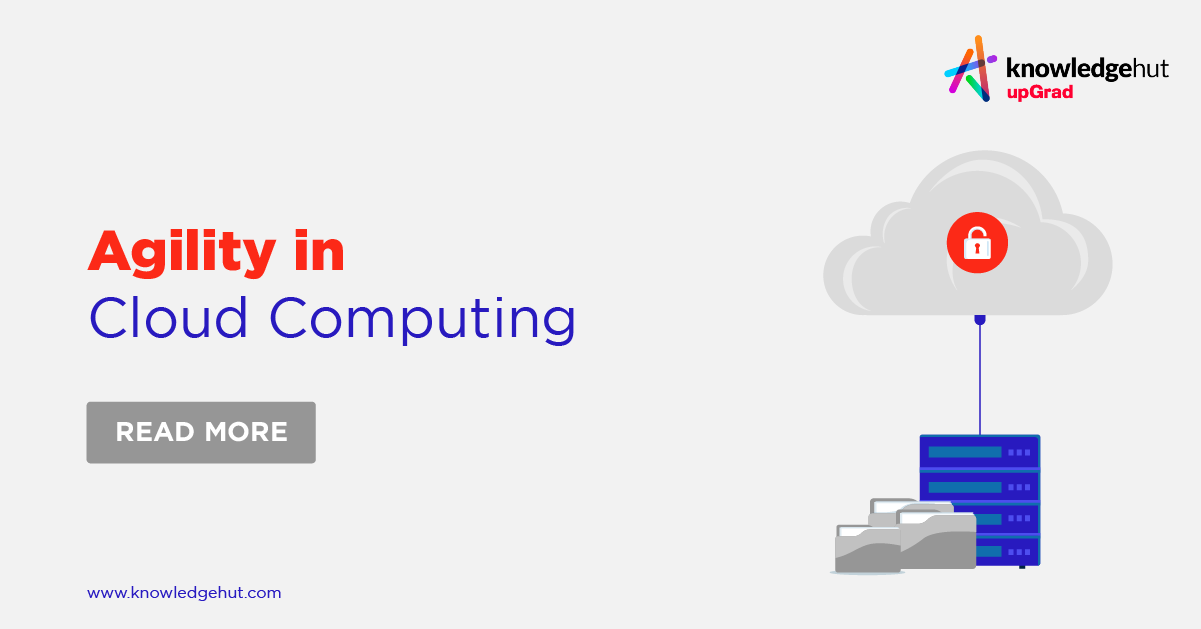How agility in cloud computing is made possible is a key advantage that is frequently addressed. This benefit is substantial and effective. However, the word “agility” is used to refer to two distinct types of advantages; both are real, but one will eventually be judged to have the biggest impact.
So, what is cloud agility? It has to do with the quick allocation of computer resources. Cloud environments can typically deploy additional compute instances or storage when compared to the customary weeks (or months, in some businesses) that the same provisioning procedure can take in typical IT shops. Those who wish to follow a career in cloud computing should go for the Best Certification Courses for Cloud Computing to help them develop these crucial skills. Taking this first step promises a bright future in cloud computing.
Agility in Cloud Computing
Rapid provisioning of computer resources through cloud computing is referred to as cloud agility. In the current IT landscape, these two are constantly at the top of a CIO’s priority list when making decisions. So, in my opinion, embracing safe cloud services and managing your IT infrastructure on the cloud to allow quicker application delivery and promote business agility constitutes cloud agility.
When used in a business setting, the term “agile” usually refers to an organization’s capacity to quickly adapt to market and environmental changes in profitable and efficient ways. The more agile your company is, the less time you will need to spend maintaining custom-written code for non-core apps and managing commodity infrastructure. When used in a business setting, the term “agile” usually refers to an organization’s capacity to quickly adapt to market and environmental changes in profitable and efficient ways. The more agile your company is, the less time you will need to spend maintaining custom-written code for non-core apps and managing commodity infrastructure.
Flexibility, balance, adaptability, and coordination are all concepts grouped under the term “agility.”
The Cloud gives organizations the tools they need to adapt to shifting customer demands. Big incentives for cloud providers and enablers include the ability to swiftly provision the resources, develop and deploy new infrastructure in minutes, or secure a new SaaS app. The cloud gives organizations the tools they need to adapt to shifting customer demands. Big incentives for cloud providers and enablers include the ability to swiftly provision the resources, develop and deploy new infrastructure in minutes, or secure a new SaaS app.
An extension of this idea is the term “cloud agile enterprise,” which describes businesses that use the concepts of complex adaptive systems to succeed. Here, the flexibility and scalability of cloud computing to provide on-demand processing and development resources are crucial.
The agility in Azure is handled by distributing the resources on your behalf. All you need to do to get started is to tell Azure how many virtual machines you want. Cloud agility is a term used frequently to describe the quickness and adaptability of the Cloud.d by distributing the resources on your behalf. All you need to do to get started is to tell Azure how many virtual machines you want. Cloud agility is a term used frequently to describe the quickness and adaptability of the cloud.
Ways to Achieve Agility in the Cloud?
- Faster Time-to-Market: By using cloud computing, businesses may drastically cut the time it takes to provision and de-provision IT infrastructure, hastening the delivery of IT projects that are essential for boosting sales or cutting costs. A cloud server can be purchased and set up in a matter of minutes as opposed to a physical server, which may take days or weeks. More rapid time to market equals more rapid time to revenue.
- Automated Resource Allocation: Cloud computing makes it easier to provide, de-provision, and re-deploy resources thanks to automation and user-friendly online consoles and APIs. When compared to managing and maintaining physical infrastructure, managing and supporting cloud infrastructure takes up much less of an IT systems administrator’s time.
- Flexibility and Scalability: Businesses may scale up or down their resources using cloud computing to respond to abrupt spikes in demand or website traffic, as well as unforeseen requirements for production or application development. According to the needs of the business, end users can “fail fast” or scale thanks to the Cloud’s pay-per-use flexibility quickly. Common workloads that require on-demand scalability include load testing, testing and development, seasonal traffic surges, new applications, and others.
- Adaptive Auto-scaling: Cloud computing leverages software, software APIs, etc., to make cloud platforms and services accessible. In a cloud context, automating IT management and provisioning is simpler. Systems can be made more adaptable by integrating cloud-based business intelligence and analytics platforms with IT monitoring tools. Cloud computing leverages software, software APIs, etc. to make cloud platforms and services accessible. In a cloud context, automating IT management and provisioning is simpler. Systems can be made more adaptable by integrating cloud-based business intelligence and analytics platforms with IT monitoring tools.
- Faster Innovation: By using the Cloud, businesses are able to enable a faster pace of product development and marketing initiatives, better aligning IT infrastructure and management costs with the company’s goals and objectives. enable a faster pace of product development and marketing initiatives, better aligning IT infrastructure and management costs with the company’s goals and objectives.
Types of Agility in Cloud
People often confuse the availability of engineering resources with business responses to shifting circumstances or opportunities when they use the term “agile.” There are two types of agility in cloud:
- Engineering resource availability
- Business response to change conditions
Although both forms of agility are advantageous, the second will ultimately prove to be more convincing and be seen as the true agility associated with cloud computing.
Delivering computational resources to engineers more quickly has the drawback of being a local optimization; while it increases the agility of some internal IT operations, it does not necessarily shorten the overall application supply chain, which runs from the initial prototype to production rollout.
There are no such issues with the second type of agility, which influences how rapidly business units can launch new products. Funding won’t be a problem if business units can establish a clear link between cloud computing and beating the competitors. When the business benefit is obvious, it never is.
Get In-depth knowledge on core services and solutions provided d with . Taking this course will help aspirants acquire entry level cloud computing jobs from where they can grow to senior levels.
How to Build an Agile IT Landscape with Cloud Computing?
1. Use Development and Test “templates” for Faster Provisioning
An application is built from core components and has user-friendly interfaces. Developers can create innovative and expert items, just like any excellent musician, by incorporating the crucial components of a stack and sticking to a predetermined tune. To help your development and test teams quickly produce full application stacks with little to no labour, think about creating complete application stacks as “templates” based on this idea.
Any cloud technology relies on virtualization at all levels. The template technique should allow for the creation of dev/test templates employing virtual machines (VMs), networks, storage, loaded apps, and security policies.
2. Create a ‘golden version’ for Each Release
Building virtual machines is only one of the difficult tasks involved in developing an application; other difficult tasks include figuring out network connections and firewall rules. Giving a complete application is therefore time-consuming and difficult, especially if you’re starting from zero.
For developers and testers, provisioning a whole environment or application may be easy and rapid thanks to the cloud. By marking the “golden version” of each release or release milestone, developers can access it whenever they want. Parallel test environments and numerous copies of any given release can be provided by test engineers. are able to provision numerous copies of each given release and parallelize test environments.
3. Work Together to Fix Complicated Bugs Quicker
Everyone dreads hearing, “But it works on my machine.” When teams are dispersed throughout the globe, the issue is only made worse because developers lose a lot of time and money working back and forth on problems, which eventually hurts the company’s bottom line. Dev/test teams can use the cloud to interact in real time and address these issues more quickly rather than permitting complex bugs or fixes to move from one person to another.
Remote teams can collaborate utilising the same online environment, allowing for real-time issue fixes and debugging, thanks to cloud solutions that provide “VM publishing” and “over the shoulder view.”
4. Inform Clients About New Versions
A bug or flaw should be discovered as soon as possible while an application is being developed. Furthermore, early design flaws and bug fixes are far easier and less expensive to remedy. To quickly detect bugs or other issues, you can use “extra eyes” and cloud technologies that let you share new versions with a small group of users.
In the “old school” model, customers are typically welcomed into the developer’s office because the team can easily set up the product rather than the end-user. These two issues are associated with this tactic: Customers frequently don’t want to travel to provide their input. Providing beta versions to a wide clientele might be challenging.
5. Automate the Process of Creating “hotfix” Repros for Customer Issues to Bring the Support, Development, Test, and Operations Teams Together
A developer’s work is done once a product is out, right? Wrong. An application’s lifespan greatly outlasts the time since its release. Even though many consumers have upgraded to the most recent release, a corporation must still provide support for users of prior versions of a product. This procedure can be made considerably more effective by using the cloud because the test/SE teams can use Steps 1-2 to duplicate prior versions, Step 3 to reproduce the current issue rather than the current state, and Step 4 to confirm the remedy with the client.
Key Advantages of Agility in Cloud Computing
The main benefits of agility in cloud computing are as follows:
1. Automated Resource Allocation
The age of automation has arrived, allowing businesses to automate more of their processes. Cloud computing is used to speed up the provisioning, de-provisioning, and deployment of IT resources by using automation, user-friendly online consoles, and APIs. In a physical environment, the IT system administrator puts a lot of effort into managing and assisting the on-premises infrastructure. They make sure that the majority of their mundane, daily tasks are automated so they can focus on the more significant issues.
2. Greater Time for Promotion
Thanks to cloud computing, businesses may considerably reduce the amount of time needed for provisioning and de-provisioning IT equipment. If IT wishes to reduce expenses and boost income, service delivery times must be increased.
Weeks used to pass as businesses waited to purchase and set up a physical server. As a result, this had a long-term impact on the company’s overall productivity. On the other hand, a cloud server works quickly to complete the task. Rapider promotion results in faster revenue growth.
3. Flexibility
Cloud agility gives businesses the flexibility they need to react to unplanned or urgent production and development needs, allowing them to scale up or down their resources to accommodate website traffic and other demands.
Due to the Cloud’s pay-per-use flexibility, end users can easily scale in response to the unpredictable needs of the enterprise. Traditional workloads that call for on-demand scalabilities, such as load testing, testing, development, peak traffic loads, or work on a new application, may be handled with ease thanks to the advantages of cloud agility.
4. Auto-Adaptive Scaling
Thanks to the Cloud, you can access cloud platforms and services using software and APIs. It is easier to automate IT provisioning and management when using a cloud environment.
5. More Rapid Innovation
Because of cloud agility, businesses may speed up product development and marketing. It aligns infrastructure costs and IT administration with the business’s goals and objectives.
6. Greater Economic Value
The advantage of cloud agility is enormous, and it greatly improves the business agility of your firm in cloud computing. A well-designed cloud solution improves your market visibility in the following ways:
- allows you to update the programme faster than your competitors.
- helps your personnel grow in a range of business-related topics.
- guarantees you’ll get exceptional availability.
- Make sure your customers have access to a reliable, time-tested offering.
Conclusion
Utilizing cloud computing is primarily motivated by faster and more cost-effective DevTest and DevOps procedures. Enterprises are relying more and more on cloud agility, nevertheless, in order to benefit from its key advantages. They can accomplish their strategic goals in this way, including developing innovative products and ideas, leading the market, having a productive workforce, and surpassing the competition.
Consideration of cloud computing as a tool for speeding IT processes is a grave error. Although internal IT agility is necessary, it won’t be sufficient in the future. Linking the usage of cloud business agility will be ever more important so that corporate innovation can hit the market quicker.
The key advantages of cloud computing might be its versatility, cost, and speedier DevOp and DevTest processes. However, businesses are using the cloud to achieve additional strategic goals such as leadership in their market, innovative products and ideas, competitiveness, and productive employees.
You may now have a better understanding of what cloud computing agility is.
It is comparatively simpler to find employment in the cloud computing industry, but you must first enroll in KnowledgeHut Best Certification Courses for Cloud Computing. By taking this course, candidates can get entry-level jobs in cloud computing from which they can advance to senior positions. finest cloud computing certification programs.
Frequently Asked Questions(FAQs)
1. What is an example of agility in the Cloud?
Due to the Cloud’s pay-per-use flexibility, end users can swiftly scale up or down in response to business demands. For instance, you may easily raise your cluster size from 10 to 50 nodes as your needs evolve.
2. How does the Cloud improve agility in business?
By lowering business complexity, the Cloud fosters business agility. Internal processes are made simpler, and more automation is made possible to achieve this. The management of IT resources is made simpler by the Cloud as well.
3. Why is cloud agility important?
Based on company needs, the Cloud offers the ability to scale up and down. This guarantees that your business is only spending money on what it actually uses and needs, and it may be a very effective way to cut costs.




















Discussion about this post